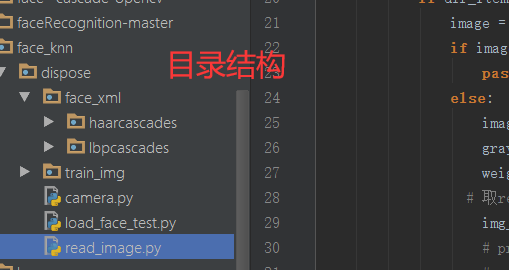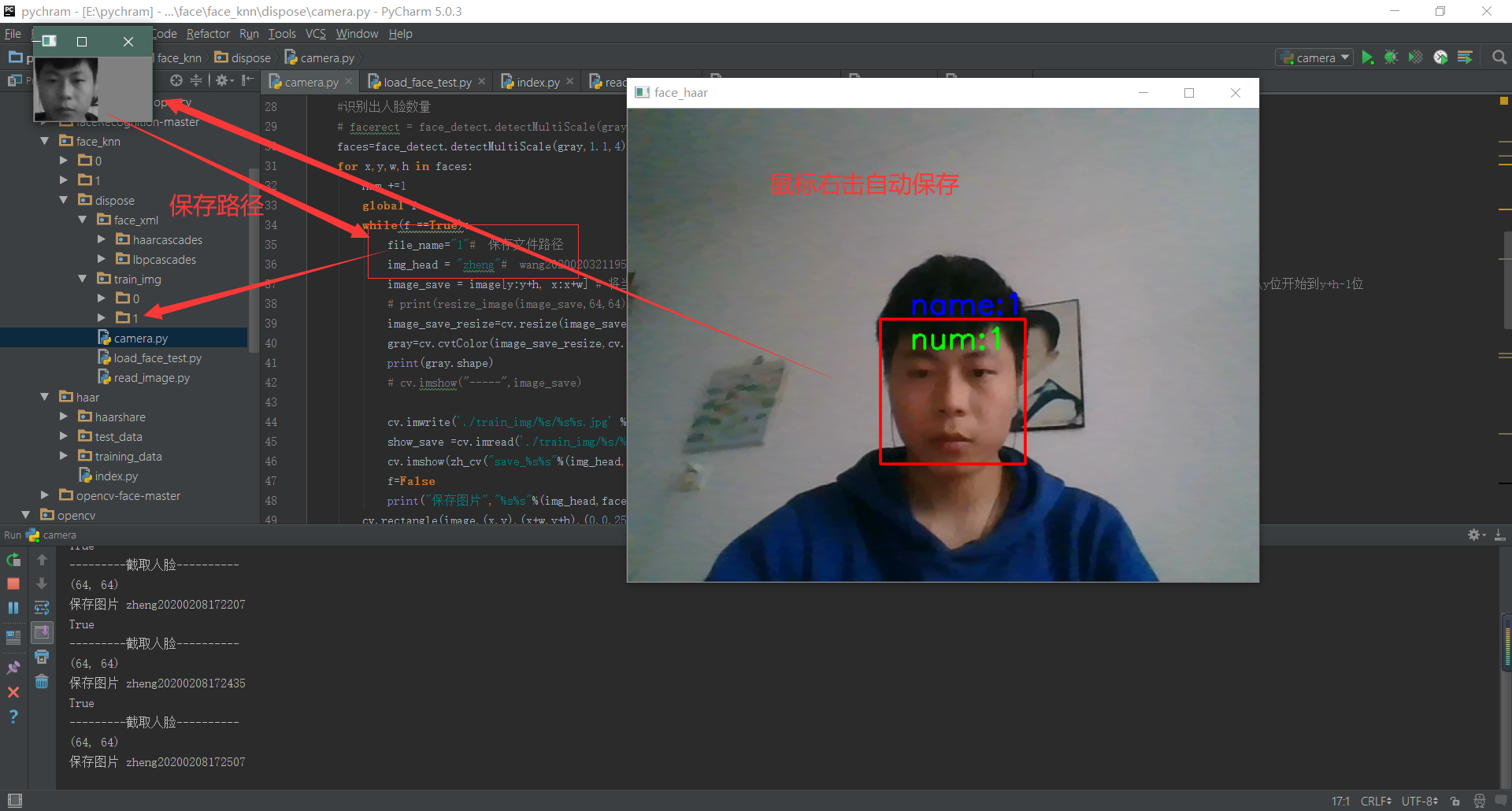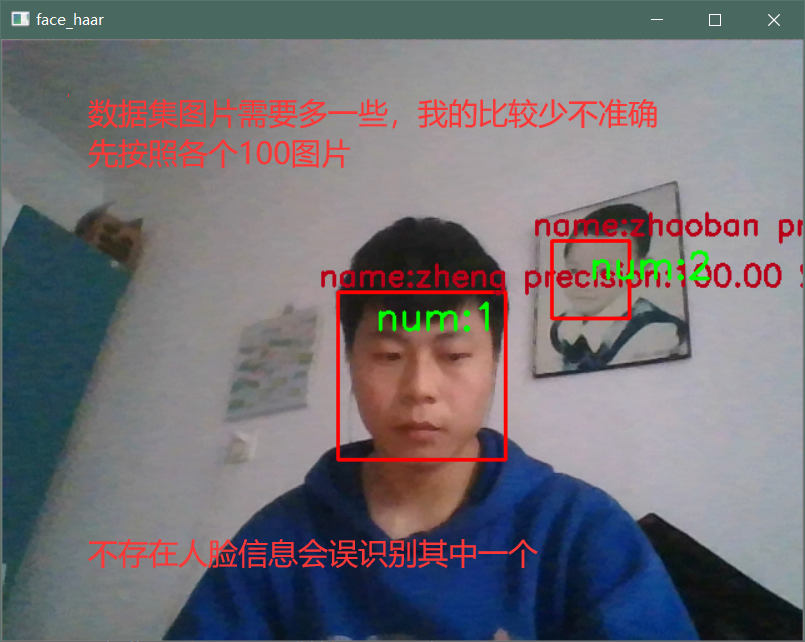需要掌握知识python,opencv和机器学习一类的基础
过一段时间代码上传github,本人菜j一个,虽然是我自己写的,也有好多不懂,或者我这就是错误方向
链接:https://pan.baidu.com/s/15IK5RWrRAr_wNLFreuK7VQ 提取码:ykkn
人脸识别的步骤:
人脸检测
haar人脸检测,
lbp人脸检测
特征处理
图片大小尺寸统一
彩色灰度转换
图片编成一维矩阵
特征提取处理
归一化
特征选择-删除低方差的特征
分析进行特征降维
训练集与测试集以一定比例数据分割
预测与训练
朴素贝叶斯算法的预测
决策树进行预测
K-近邻预测
得出准确率
程序运行:自己安装调用的库

camera.py 运行会调用笔记本摄像头,鼠标右击会保存摄像头检测的人脸,保存到0和1文件夹,但是保存文件的路径需要自己手改

read_image 会调用保存两个文件夹采集的人脸数据图片,test_pre方法读取的图片路径使用自己人脸照片(属于上面采集两个人脸之一)
load_face_test.py 是把俩个程序结合出来,再有人脸数据集和haarcascades和lbp(opencv自带人脸检测网上可下就是慢,lbp是对比用的,我这里最后没有使用)

# camera.py 运行会调用笔记本摄像头,鼠标右击会保存摄像头检测的人脸,保存到0和1文件夹,但是保存文件的路径需要自己手改
import cv2 as cv import time def zh_cv(string): return string.encode("gbk").decode(errors="ignore") def get_video(): capture =cv.VideoCapture(0)# VideoCapture(0) 开发默认摄像头,如果你有多个摄像头可以试试除0之外的其他参数 print("-----打开摄像头--------") while(capture.isOpened()) : ret, frame=capture.read() if ret ==False : break; # print(frame) cv.flip(frame,1)# 左右变换 # print("---------haar检测算法----------") face_detect_dome(frame) # face_lbp_dome(frame) # cv.imshow("voide",frame) # cv.imshow(zh_cv("摄像头"),frame) c=cv.waitKey(50) if c == 27: break; def face_detect_dome(image): num =0 gray=cv.cvtColor(image,cv.COLOR_BGR2GRAY) face_detect=cv.CascadeClassifier("./face_xml/haarcascades/haarcascade_frontalface_alt.xml") #识别出人脸数量 # facerect = face_detect.detectMultiScale(gray, scaleFactor=1.2, minNeighbors=3, minSize=(12, 12)) faces=face_detect.detectMultiScale(gray,1.1,4) for x,y,w,h in faces: num +=1 global f while(f ==True): file_name="1"# 保存文件路径 img_head = "zheng"# wang20200203211958 image_save = image[y:y+h, x:x+w] # 将当前帧含人脸部分保存为图片,注意这里存的还是彩色图片,前面检测时灰度化是为了降低计算量;这里访问的是从y位开始到y+h-1位 # print(resize_image(image_save,64,64)) image_save_resize=cv.resize(image_save,(64,64)) gray=cv.cvtColor(image_save_resize,cv.COLOR_BGR2GRAY)# 灰度 print(gray.shape) # cv.imshow("-----",image_save) cv.imwrite('./train_img/%s/%s%s.jpg' %(file_name,img_head,face_time()), gray) show_save =cv.imread('./train_img/%s/%s%s.jpg' %(file_name,img_head,face_time())) cv.imshow(zh_cv("save_%s%s"%(img_head,face_time())),show_save) f=False print("保存图片","%s%s"%(img_head,face_time())) cv.rectangle(image,(x,y),(x+w,y+h),(0,0,255),2) # 原图 位置 ,h 颜色 # cv.namedWindow("face lbp",cv.WINDOW_NORMAL) # 显示当前捕捉到了多少人脸图片了 font = cv.FONT_HERSHEY_SIMPLEX cv.putText(image, 'num:%d' % (num), (x + 30, y + 30), font, 1, (0, 255, 0), 2) cv.putText(image, 'name:%d' % (num), (x + 30, y -5), font, 1, (255, 0, 0), 2) # cv.namedWindow("face_haar",cv.WINDOW_NORMAL) cv.setMouseCallback('face_haar',img_save) cv.imshow("face_haar",image) def face_lbp_dome(image): gray=cv.cvtColor(image,cv.COLOR_BGR2GRAY) face_detect=cv.CascadeClassifier("./face_xml/lbpcascades/lbpcascade_frontalface.xml") faces=face_detect.detectMultiScale(gray,1.1,4) print("---------lbp----------") for x,y,w,h in faces: cv.rectangle(image,(x,y),(x+w,y+h),(0,0,255),2) # 原图 位置 w,h 颜色 cv.namedWindow("face_lbp",cv.WINDOW_NORMAL) cv.setMouseCallback('face_lbp',img_save) cv.imshow("face_lbp",image) def img_save(event, x, y, flags, param): global f if event == cv.EVENT_RBUTTONDOWN: f = True print(f) print("---------截取人脸----------") # cv.waitKey(0) def face_time(): # print(time.strftime("%Y%m%d%H%M%S", time.localtime())) n_time =str(time.strftime("%Y%m%d%H%M%S", time.localtime())) return n_time if __name__ == '__main__': f = False get_video()
#read_image 会调用保存两个文件夹采集的人脸数据图片,test_pre方法读取的图片路径使用自己人脸照片(属于上面采集两个人脸之一)
import os from sklearn.preprocessing import MinMaxScaler, StandardScaler from sklearn.decomposition import PCA import numpy as np from sklearn.model_selection import train_test_split, GridSearchCV from sklearn.preprocessing import StandardScaler from sklearn.naive_bayes import MultinomialNB import cv2 images = [] labels = [] img_list =[] # path_name是当前工作目录,后面会由os.getcwd()获得 def read_path(path_name): for dir_item in os.listdir(path_name): # os.listdir() 方法用于返回指定的文件夹包含的文件或文件夹的名字的列表 # 从当前工作目录寻找训练集图片的文件夹 full_path = os.path.abspath(os.path.join(path_name, dir_item)) if os.path.isdir(full_path): # 如果是文件夹,继续递归调用,去读取文件夹里的内容 read_path(full_path) else: # 如果是文件了 if dir_item.endswith('.jpg'): image = cv2.imread(full_path) if image is None: # 遇到部分数据有点问题,报错'NoneType' object has no attribute 'shape' pass else: image_resize=cv2.resize(image,(64,64)) gray=cv2.cvtColor(image_resize,cv2.COLOR_BGR2GRAY)# 灰度 weight,height = gray.shape # 取reshape后的矩阵的第一维度数据,即所需要的数据列表 img_reshape = gray.reshape(1,weight*height)[0] # print(list(img_reshape)) # 转换列表添加images image_list=list(img_reshape) images.append(image_list) # global labels labels.append(path_name) # 标注数据,me文件夹下是我,指定为0,其他指定为1,这里的0和1不是logistic regression二分类输出下的0和1,而是softmax下的多分类的类别 label = np.array(["%s"%"zhaoban" if label.endswith("%d"%0) else "unknow" for label in labels]) # label = np.array([endwith(labels)]) return images,label def mm(img_mm): """ 归一化处理 :return: NOne """ mm = MinMaxScaler(feature_range=(0,1)) data = mm.fit_transform(img_mm) print(data) print("----------归一化处理-------------") return data def pca(img_pca): """ 主成分分析进行特征降维 :return: None """ pca = PCA(n_components=0.9) data = pca.fit_transform(img_pca) print("------------主成分分析进行特征降维---------------") # print(data) return data def stand(stand_data): """ 标准化缩放 :return: """ std = StandardScaler() data = std.fit_transform(stand_data) # print(data) return data def naviebayes(data,target): """ 朴素贝叶斯进行文本分类 :return: None,t """ # news = fetch_20newsgroups(subset='all') # 进行数据分割 x_train, x_test, y_train, y_test = train_test_split(data,target, test_size=0.25) mlt = MultinomialNB(alpha=1.0) mlt.fit(x_train, y_train) # print(x_test) # print(test_pre()) y_predict = mlt.predict(test_pre()) print("分类类别为:", y_predict) # # 得出准确率 print("准确率为:", mlt.score(x_test, y_test)) return None def test_pre(): image_test =[] image =cv2.imread("qq.jpg") image_resize=cv2.resize(image,(64,64)) gray=cv2.cvtColor(image_resize,cv2.COLOR_BGR2GRAY)# 灰度 weight,height = gray.shape # 取reshape后的矩阵的第一维度数据,即所需要的数据列表 img_reshape = gray.reshape(1,weight*height)[0] # print(list(img_reshape)) # 转换列表添加images image_list=list(img_reshape) image_test.append(image_list) return image_test if __name__ == "__main__": # print(read_path("./train_img/")) images ,labels= read_path("./train_img/") # image_mm =mm(images) # image_stand =stand(image_mm) # image_pca=pca(image_mm) print("---------------------------------------") naviebayes(images,labels) print("-----------------")
#load_face_test.py 是把俩个程序结合出来,再有人脸数据集和haarcascades和lbp(opencv自带人脸检测网上可下就是慢,lbp是对比用的,我这里最后没有使用) import cv2 as cv import time import os from sklearn.preprocessing import MinMaxScaler, StandardScaler from sklearn.decomposition import PCA import numpy as np from sklearn.model_selection import train_test_split, GridSearchCV from sklearn.preprocessing import StandardScaler from sklearn.naive_bayes import MultinomialNB import cv2 images = [] labels = [] img_list =[] # path_name是当前工作目录,后面会由os.getcwd()获得 def read_path(path_name): for dir_item in os.listdir(path_name): # os.listdir() 方法用于返回指定的文件夹包含的文件或文件夹的名字的列表 # 从当前工作目录寻找训练集图片的文件夹 full_path = os.path.abspath(os.path.join(path_name, dir_item)) if os.path.isdir(full_path): # 如果是文件夹,继续递归调用,去读取文件夹里的内容 read_path(full_path) else: # 如果是文件了 if dir_item.endswith('.jpg'): image = cv2.imread(full_path) if image is None: # 遇到部分数据有点问题,报错'NoneType' object has no attribute 'shape' pass else: image_resize=cv2.resize(image,(64,64)) gray=cv2.cvtColor(image_resize,cv2.COLOR_BGR2GRAY)# 灰度 weight,height = gray.shape # 取reshape后的矩阵的第一维度数据,即所需要的数据列表 img_reshape = gray.reshape(1,weight*height)[0] # print(list(img_reshape)) # 转换列表添加images image_list=list(img_reshape) images.append(image_list) # global labels labels.append(path_name) # 标注数据,me文件夹下是我,指定为0,其他指定为1,这里的0和1不是logistic regression二分类输出下的0和1,而是softmax下的多分类的类别 # dict ={0:"办",1:"long"} # for key in range(2): # print(dict[key]) label = np.array(["%s"%"zheng" if label.endswith("%d"%1) else "zhaoban" for label in labels]) # label = np.array(["%s"%dict[i] if label.endswith("%d"%(i for i in range(2))) for label in labels]) return images,label def mm(img_mm): """ 归一化处理 :return: NOne """ mm = MinMaxScaler(feature_range=(0,1)) data = mm.fit_transform(img_mm) print(data) print("----------归一化处理-------------") return data def pca(img_pca): """ 主成分分析进行特征降维 :return: None """ pca = PCA(n_components=0.9) data = pca.fit_transform(img_pca) print("------------主成分分析进行特征降维---------------") # print(data) return data def stand(stand_data): """ 标准化缩放 :return: """ std = StandardScaler() data = std.fit_transform(stand_data) # print(data) return data def naviebayes(data,target,test_img): """ 朴素贝叶斯进行文本分类 :return: None,t """ # news = fetch_20newsgroups(subset='all') # 进行数据分割 x_train, x_test, y_train, y_test = train_test_split(data,target, test_size=0.25) mlt = MultinomialNB(alpha=1.0) mlt.fit(x_train, y_train) # print(x_test) # print(test_pre()) y_predict = mlt.predict(test_img) print("分类类别为:", y_predict) # # 得出准确率 print("准确率为:", mlt.score(x_test, y_test)) return y_predict,mlt.score(x_test, y_test) def test_pre(gray): image_test =[] weight,height = gray.shape # 取reshape后的矩阵的第一维度数据,即所需要的数据列表 img_reshape = gray.reshape(1,weight*height)[0] # print(list(img_reshape)) # 转换列表添加images image_list=list(img_reshape) image_test.append(image_list) return image_test def zh_cv(string): return string.encode("gbk").decode(errors="ignore") def get_video(): capture =cv.VideoCapture(0)# VideoCapture(0) 开发默认摄像头,如果你有多个摄像头可以试试除0之外的其他参数 print("-----打开摄像头--------") while(capture.isOpened()) : ret, frame=capture.read() if ret ==False : break; # print(frame) cv.flip(frame,1)# 左右变换 # print("---------haar检测算法----------") face_detect_dome(frame) # face_lbp_dome(frame) # cv.imshow("voide",frame) # cv.imshow(zh_cv("摄像头"),frame) c=cv.waitKey(50) if c == 27: break; def face_detect_dome(image): num =0 gray=cv.cvtColor(image,cv.COLOR_BGR2GRAY) face_detect=cv.CascadeClassifier("./face_xml/haarcascades/haarcascade_frontalface_alt.xml") #识别出人脸数量 # facerect = face_detect.detectMultiScale(gray, scaleFactor=1.2, minNeighbors=3, minSize=(12, 12)) faces=face_detect.detectMultiScale(gray,1.1,4) for x,y,w,h in faces: num +=1 image_save = image[y:y+h, x:x+w] # 将当前帧含人脸部分保存为图片,注意这里存的还是彩色图片,前面检测时灰度化是为了降低计算量;这里访问的是从y位开始到y+h-1位++ # print(resize_image(image_save,64,64)) image_save_resize=cv.resize(image_save,(64,64)) gray=cv.cvtColor(image_save_resize,cv.COLOR_BGR2GRAY)# 灰度 predict,score =naviebayes(images,labels,test_pre(gray)) print(score) global f # while(f ==True): # file_name="0" # img_head = "wang"# wang20200203211958 # print(gray.shape) # cv.imwrite('./train_img/%s/%s%s.jpg' %(file_name,img_head,face_time()), gray) # show_save =cv.imread('./train_img/%s/%s%s.jpg' %(file_name,img_head,face_time())) # cv.imshow(zh_cv("save_%s%s"%(img_head,face_time())),show_save) # f=False # print("保存图片","%s%s"%(img_head,face_time())) # image_test =cv.imread('./train_img/%s/%s%s.jpg' %(file_name,img_head,face_time())) # cv.imshow("-----",image_save) cv.rectangle(image,(x,y),(x+w,y+h),(0,0,255),2) # 原图 位置 ,h 颜色 # cv.namedWindow("face lbp",cv.WINDOW_NORMAL) # 显示当前捕捉到了多少人脸图片了 font = cv.FONT_HERSHEY_SIMPLEX cv.putText(image, 'num:%d' % (num), (x + 30, y + 30), font, 1, (0, 255, 0), 2) cv.putText(image, 'name:%s precision:%3.2f %%' % (predict[0],score*100),(x -15, y -5), font, 0.8, (25, 0, 185), 2) #cv.namedWindow("face_haar",cv.WINDOW_NORMAL) cv.setMouseCallback('face_haar',img_save) cv.imshow("face_haar",image) def face_lbp_dome(image): gray=cv.cvtColor(image,cv.COLOR_BGR2GRAY) face_detect=cv.CascadeClassifier("./face_xml/lbpcascades/lbpcascade_frontalface.xml") faces=face_detect.detectMultiScale(gray,1.1,4) print("---------lbp----------") for x,y,w,h in faces: cv.rectangle(image,(x,y),(x+w,y+h),(0,0,255),2) # 原图 位置 w,h 颜色 cv.namedWindow("face_lbp",cv.WINDOW_NORMAL) cv.setMouseCallback('face_lbp',img_save) cv.imshow("face_lbp",image) def img_save(event, x, y, flags, param): global f if event == cv.EVENT_RBUTTONDOWN: f = True print(f) print("---------截取人脸----------") # cv.waitKey(0) def face_time(): # print(time.strftime("%Y%m%d%H%M%S", time.localtime())) n_time =str(time.strftime("%Y%m%d%H%M%S", time.localtime())) return n_time if __name__ == '__main__': f = False images ,labels= read_path("./train_img/") get_video()